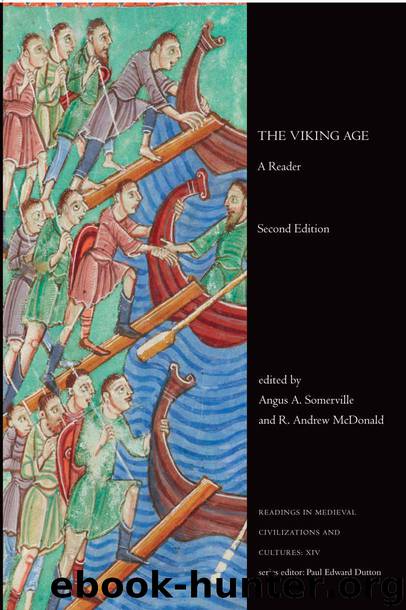The Viking Age: A Reader, Second Edition (Readings in Medieval Civilizations and Cultures) by Angus A. Somerville && R. Andrew McDonald

Author:Angus A. Somerville && R. Andrew McDonald
Language: eng
Format: azw3
ISBN: 9781442608702
Publisher: University of Toronto Press, Higher Education Division
Published: 2014-09-22T04:00:00+00:00
54. Ketil Flatnose and his Descendants in the Hebrides
Scandinavian settlement in the Hebrides, the numerous islands off Scotland’s west coast, is undocumented in contemporary sources and must be traced from archaeological and place-name evidence in the first instance, but a significant Scandinavian presence there is not in doubt. From the ninth century a series of rulers with Scandinavian names and backgrounds began to appear in the region. Ketil Flatnose was a prominent Norse sea-king associated with the Hebrides. He appears in several Icelandic sagas, and some scholars believe he should be identified with Caittil the Fair mentioned in the Annals of Ulster under the year 857, while others doubt this association. The Icelandic saga tradition is not entirely in agreement on his role either, but the various sagas that mention him agree that he participated in an expedition to the Western Isles and established himself there. On Ketil and his descendants see doc. 20.
Source: trans. A.A. Somerville, from Eyrbyggja saga, ed. Einar Ól. Sveinsson and Matthías Þórðarson, Íslenzk fornrit IV (Reykjavík, 1935), pp. 3–4.
1. There was a distinguished hersir [chief, lord] in Norway, called Ketil Flatnose. He was the son of Bjorn Buna [Club-Foot], who was the son of Grim the hersir from Sogn. Ketil was married to Yngvild, the daughter of Ketil Wether, a hersir from Raumarike. Their sons were called Bjorn and Helgi, and their daughters were Aud [Unn] the Deep-Minded, Thorunn Hyrna [Horned] and Jorunn Manvitsbrekka. Ketil’s son, Bjorn, was fostered by Earl Kjallak in Jämtland [Norway]. The earl was a wise and distinguished man, with a son called Bjorn, and a daughter, Gjaflaug.
This was in the days when Harald Finehair came to power in Norway. Because of that turbulence, many noble men fled their ancestral estates in Norway. Some went east over the Kiolen Mountains and others went west across the sea. There were some who wintered in the Shetlands or the Orkneys and raided Norway in the summers, doing great damage in King Harald’s kingdom. The farmers complained to the king and asked him to free them from this trouble. The king decided to get an army ready to cross the western sea and said that Ketil Flatnose would be in command. Ketil declined, but the king declared that he had to go. When Ketil saw that the king intended to have his way, he got ready for the journey and took with him his wife and those of his children who were at home.
After he had crossed to the west, Ketil fought several battles and always won. He took control of the Hebrides and made himself ruler there. Then he came to terms with the most powerful chiefs on that side of the western sea and formed alliances with them. He sent the army back east, and, when they met King Harald, they told him that Ketil Flatnose was the ruler of the Hebrides, but declared that they did not know if he would present the king with a kingdom across the western sea. When the king heard that, he seized all that Ketil owned in Norway.
Download
This site does not store any files on its server. We only index and link to content provided by other sites. Please contact the content providers to delete copyright contents if any and email us, we'll remove relevant links or contents immediately.
Letters From a Stoic by Seneca(2736)
The Valmiki Ramayana: Vol. 1 by Bibek Debroy(2383)
The Valmiki Ramayana: Vol. 2 by Bibek Debroy(2247)
The Valmiki Ramayana: Vol. 3 by Bibek Debroy(2145)
Mary Boleyn by Alison Weir(1849)
The Greeks by H. D. F. Kitto(1712)
The Notebooks of Leonardo Da Vinci by Da Vinci Leonardo(1569)
The Classics by Mary Beard(1545)
Mythos (2019 Re-Issue) by Stephen Fry(1519)
The Voynich Manuscript by Gerry Kennedy(1447)
Medea and Other Plays by Euripides(1403)
Art of Living by Sellars John;(1401)
Annals by Tacitus(1379)
Hindoo Holiday by J. R. Ackerley(1315)
Claudius the God by Robert Graves(1266)
Appeasement of Radhika by Muddupalani(1244)
Atlantis the Lost Continent Finally Found by Arysio Santos(1219)
Kadambari: Bana by Bana(1209)
THE REPUBLIC by plato(1208)
